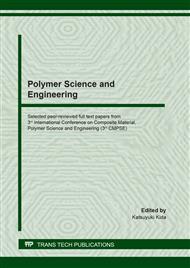[1]
C. Makabe, M. Fujikawa, M. S. Ferdous, S. A. Setyabudi, Fatigue Strength of Notched Specimen of Machinable C/C Composites, JHPI, Vol. 51, (2013) No.6, pp.7-15.
Google Scholar
[2]
M. S. Ferdous, S. A. Setyabudi, C. Makabe, M. Fujikawa, Fatigue Behavior and the Relationship between Crack Propagation and the Slit Configuration of C/C Composites, Modern Physics Letters B, Vol. 21 (2013) No.13, pp.1350094-11.
DOI: 10.1142/s0217984913500942
Google Scholar
[3]
K. Goto, H. Hatta, Effect of shear damage on the fracture behavior of carbon-carbon composites, Journal of American Ceramic Society, Vols. 84 (2001), pp.1327-1333.
DOI: 10.1111/j.1151-2916.2001.tb00837.x
Google Scholar
[4]
S. Setyabudi, C. Makabe, M. Fujikawa, Relationship between Crack Extension Behavior and Fatigue Life of C/C Composites, Key Engineering Materials, Vols. 525-526 (2013), pp.613-616.
DOI: 10.4028/www.scientific.net/kem.525-526.613
Google Scholar
[5]
A. Murdani, C. Makabe and M. Fujikawa, Fatigue and Fracture Behavior in Notched Specimens of C/C Composite with Fine-Woven Carbon Laminates, Carbon, Vols. 47 (2009), pp.3355-3364.
DOI: 10.1016/j.carbon.2009.08.003
Google Scholar
[6]
H. Sun, N. Pan, Shear deformation analysis for woven fabrics, Composite Structure, Vols. 67 (2005), pp.317-322.
DOI: 10.1016/j.compstruct.2004.01.013
Google Scholar
[7]
H. Hatta, K. Goto, T. Aoki. Strengths of C/C composites under tensile, shear, and compressive loading: Role of interfacial shear strength, Composites Science and Technology, Vols. 65 (2005), pp.2550-2562.
DOI: 10.1016/j.compscitech.2005.07.012
Google Scholar
[8]
L. Denk, H. Hatta, S. Somiya, H. Misawa, Fracture behavior of multi-holed C/C composites, Advanced Composite Materials, Vols. 12 (2003), pp.107-122.
DOI: 10.1163/156855103772658506
Google Scholar
[9]
K. Goto, Y. Furukawa, H. Hatta and Y. Kogo, Fatigue Behavior of 2D Laminate C/C Composites at Room Temperature, Composites Science and Technology, Vols. 65 (2005), pp.1044-1051.
DOI: 10.1016/j.compscitech.2004.09.031
Google Scholar
[10]
Y. Kogo, H. Hatta, H. Kawada, T. Machida, Effect of stress concentration on tensile fracture behavior of carbon-carbon composites, Journal of Composite Materials, Vols. 32 (1998), pp.1273-1294.
DOI: 10.1177/002199839803201302
Google Scholar
[11]
H. Nisitani, A. Saimoto, Effectiveness of Two-Dimensional Versatile Program based on Body Force Method and its Applications to Crack Problems, Key Engineering Materials, Vols. 251 & 252, (2003), pp.97-102.
DOI: 10.4028/www.scientific.net/kem.251-252.97
Google Scholar


